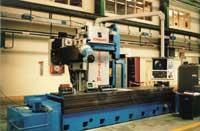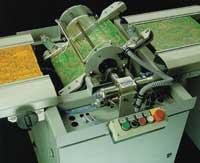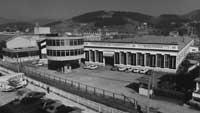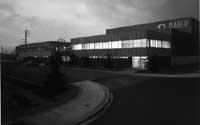Flexibility as a way of competitiveness
1997/12/01 Aranguren, Mari Jose Iturria: Elhuyar aldizkaria
The economy of the Autonomous Community of the Basque Country, of course, has its own characteristics. These unstable areas are called turbulent areas.
It can be analyzed according to the causes of turbulence, distinguishing the different types of turbulence.
Request for turbulence

It is often said that there is turbulence in demand when there are large variations in the products requested and in their quantity or when the markets are very variable.
The convergence of the world economy increases the variability of sales, caused mainly by the lack of stability of foreign competitiveness and the exchange rate.
When markets open, competition between companies becomes harder and each has to differentiate their products. In addition, in recent years there has been a trend change in relation to the product itself, moving from the demand for standardized products that could be produced in series to the demand for differentiated products tailored to the customer. These products cannot be produced in series, so more flexible production systems are needed.
If we want to analyze why demand has changed, we will have to take into account several factors; on the one hand, by improving our level of quality of life, the hierarchy of our needs has been evolving and consumers are increasingly demanding; on the other hand, the level of education of consumers today is better and, in addition, the development of communications, computing, electronics and telecommunications facilitates access to more information about the markets; the customer knows the products and knows the products. As a result, companies move in the market with competitors from all over the world.
And, obviously, the company that aspires to last in this current globalized economy must also go in search of foreign markets.
Turbulence on offer
It is often said that there are turbulence in the supply when changes occur in technology, in the competitive position and in the market of each.

The turbulence caused by changes in technologies is the result of a strong struggle for access to new technologies that can be used to be more competitive. Studies such as the development of new technologies (the replacement of electronic mechanisms by mechanics, the use of numerical control systems, computer-aided CAD design and CAM production, etc.) have confirmed a decline in economies of scale associated with the size of economic units. In this sense we can analyze the study carried out by the Acs Audretsch group in 1990: the implementation of flexible technologies has allowed to reduce the unit costs of small units to a greater extent than those of larger size. As a result, the cost disadvantages of small economic units compared to large ones have been decreasing.
It has also been commented that the changes that occur between the competition generate turbulence; due to the changes that occur in the products requested, in the quantity or in the available technologies, the new economic units can have the opportunity to enter a sector through the production of a new product or the application of new technologies.
As we have seen, turbulence can be due to many factors; in a time a company could be very quiet thinking that it had the lowest labor costs of the market, but today this is not possible. Many of the studies of Industrial Economy are witnesses of the profound changes that are taking place on the basis that to be competitive in a globalized market like the current one, the main objectives of the company are not the quality and must go from being a good service to an objective of flexibility.
Towards flexibility
Nor is it easy to give a precise definition of flexibility. Stigler (1939) was, in this context, the first to use the concept of flexibility in economic literature in relation to the functioning of companies. If the ratio between unit costs and company output is U-shaped, the flatter the bottom of this curve (the less you change marginal costs compared to the number of outputs) the greater the flexibility of the company in production costs.

However, flexibility is more than just adapting to demand declines. The company must be able to adapt to changing technical knowledge, fashion, consumer preferences and other factors affecting costs. Thus, after the definition given by Stigler, wider definitions can be found in works by authors such as Marschak et. al (1962), Jones Ostroy (1984), Gustavsson (1984) and Harrigan (1985), among others. Accordingly, we consider that a company is flexible if in later years it is easier and cheaper to move to the new situation.
In this sense, it is worth moving what Harrigane said to the company's ability to reposition itself in the market, adapt its plans and revolutionize unattractive strategies for its customers.
In general, therefore, and in a nutshell, we can define flexibility as the ability to face the different types of turbulence we have foreseen. The company must be able to cope with each type of turbulence, so the types of flexibility can also be analyzed based on this criterion.
- Process flexibility. Within it we can see two other types of flexibility:
- flexibility in the amount requested: ability to respond to demand changes using the same production system.
- technical flexibility: ability to apply new production processes.
- Product/market flexibility. Here you can also consider two other features:
- Product flexibility: ability to produce new products.
- market flexibility: ability to approach new markets.
As mentioned above, the importance of flexibility to be competitive is now fully assumed, and in the following statement practically all current researchers agree: flexibility being able to face different types of turbulence, its importance is even more evident in sectors of high turbulence. In other words, the flexibility of the products that are demanded in sectors where characteristics, quantities, technologies and markets change substantially is fundamental for the company that wants to be competitive, while in stable sectors to competition is usually not so important.
Situation in the ACBC

With the sources of information available, it is not easy to measure the different types of turbulence and, of course, that is what we should do if we want to know what are the sectors of high turbulence or low stability of the ACBC. In some sectors, such as primary, services, etc., it is even more difficult to obtain the necessary data, so in this paper we will limit ourselves to measuring the degree of turbulence in the manufacturing sectors.
Nor are we going to measure all kinds of turbulence here. Based on the information provided by the statistical sources, in our case the Eustat establishment directories and the Industrial Surveys, we will work on the turbulence of the products requested, the turbulence of the quantity of products requested and that of the person making the offer, collecting the systems and variables that we have used for this in the annex. The conclusions obtained when analyzing the influence of these three types of turbulence in the Basque manufacturing industry are shown in Table 1. Once this table is explained, we have reached the following conclusions.
- The sectors with the lowest turbulence in the ACBC are the treatment of glass, other non-metallic, foundries, cars and spare parts, beverages, graphic arts and plastics, with none of the three turbulence being measured.
- Sectors with low turbulence include basic chemistry, metals, leather and footwear treatment, rubber and tires, although with significant variations in product numbers, no significant variations in competition and products have been measured.
- Regarding metallic construction, shipbuilding, bakery, miller sector, fish canning, wood treatment and furniture, the degree of turbulence is low, although variations occur between large competitors, no significant variations in products and quantities have been measured.
- Non-metallic minerals, cement, final chemistry, electrical appliances, the dairy industry and clothing present a low degree of turbulence if the three types that are being measured are taken into account, however great product changes occur in these sectors.
- It has been concluded that there is a high degree of turbulence in the following sectors, since of the three turbulence models being measured, at least two have clearly appeared:
- Metallic minerals, non-ferrous metallurgy, ironworks and stamping, other food industries and other manufactures, all of them highlight the variations between competitors and the incidents that occur in demand.
- Industrial chemistry, other machinery, office tools and precision, other electrical materials and other transport materials, sectors in which variation between competitors and product demand are important.
- In the machine tool, chocolate, textile and paper industry highlight product and quantity incidents.
- Finally, the steel industry and the meat industry are the sectors of the CAPV with the highest degree of turbulence, with changes in competition and variations in products and quantities especially significant in both sectors.
Undoubtedly, flexibility is a way of competitiveness in all sectors. However, flexibility plays a fundamental role in those sectors with a high degree of turbulence.
1. Turbulence of the products requested: To measure this factor we have departed from the directory of establishments of the Eustat. This directory lists the three main activities of each establishment using 4 digits of the CNAE-74 classification. Knowing the sectorization C of Eustat we know which sectors of each activity of the CNAE 4 digits can be assigned. Directories from 1990 to 1993 have been used for measurement. To measure turbulence in the sector has been used as variable the percentage of establishments that have changed product in these 4 years. For the calculation of this variable it has been considered that in a establishment there has been a change of product from one year to another and that the main activity (represented by the digits CNAE-74 4) has been modified by sectors (using the sectorization C of Eustat). where: EPT = {IAEKs/BATKs} * 100 EPT: turbulence of the products requested. BATK s: Average number of establishments in the sector s in the period 1990-93. CECA: Number of establishments that between 1990 and 93 modify their main activity in the sector. 2. Turbulence of the quantity of products requested: Since the Eustat Industrial Survey we have analyzed production between 1985 and 1993. Knowing this, placing the production of 1993 according to the production of previous years by multiple regression, we have calculated the inverse of the direct regression determination coefficient (R2), by which we have measured the turbulence of the number of products requested. 3. Turbulence offer: Measured by establishment changes in a range above 99 workers. This turbulence has been measured in the percentage of establishments entering and leaving this section compared to the number of existing establishments in each sector. where: ET: supply turbulence. E 99: Intermediate income above 99 employees. S 99: Average number of workers in the 1985-93 section in which the average workforce is over 99 workers. |
| Information | STP 1.5. | Information | |
Metallic minerals | X | X | |
Engineering | X | X | X |
Non-ferrous metallurgy | X | X | |
Non-metallic minerals | X | ||
Cement | X | ||
Glass | |||
Other non-metallic | |||
Basic chemistry | X | ||
Industrial chemistry | X | X | |
Final chemistry | X | ||
Foundries | |||
Forging and stamping | X | X | |
Metal construction | X | ||
Metal articles | X | ||
Machine tools | X | X | |
Other machinery | X | X | |
Office machines and doitas. | X | X | |
Appliances | X | ||
Other electric material | X | X | |
Cars and parts | |||
Shipbuilding | X | ||
Other transport material | X | X | |
Meat industry | X | X | X |
Dairy industries | X | ||
Canned fish | X | ||
Bakery and milling | X | ||
Chocolate | X | X | |
Other food industries | X | X | |
Drinks | |||
Tobacco | |||
Textile industry | X | X | |
Clothing | X | ||
Leather and footwear | X | ||
Wood | X | ||
Wooden furniture | X | ||
Paper | X | X | |
Graphic arts | |||
Rubber and tires | X | ||
Plastic items |
Other manufactures
XX
Gai honi buruzko eduki gehiago
Elhuyarrek garatutako teknologia





